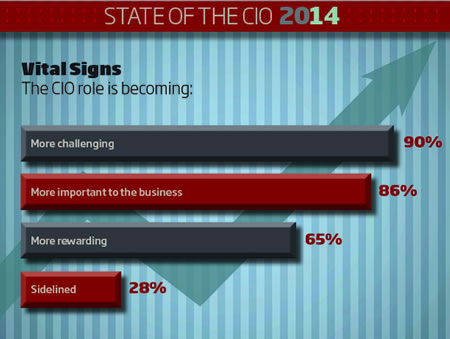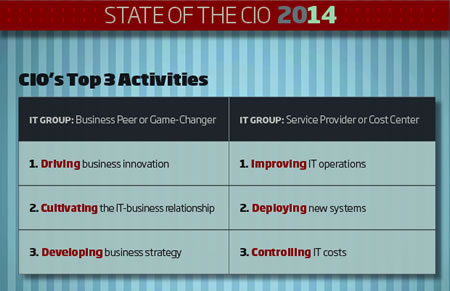How will the role of the CIO evolve in 2014? The safest bet in making such predictions is saying “the same way it did in 2013”. Evolutions are not bound to calendar years. However, with the ongoing digitalization and increasing pressure on IT from the business as is happening for some years now, a few trends and shifts might happen faster than many expect while new technologies bring new questions, challenges and opportunities.
Shifting business priorities, changing consumer behavior, different demands regarding work and the speed of a globalized and ever faster ‘real-time’ economy, have a huge effect on the IT department and the CIO. Add to that increasing pressure and shifting technological priorities/challenges and the picture is clear.
The general attitude among business executives towards IT and the CIO is not very positive. This is especially true in divisions and across business functions where the demand for digital technologies and skills is very high.
Marketing and customer-facing executives are clearly among those putting most pressure on IT as they feel the heat of a digital and connected “prosumer” and the inability to respond properly to changing shopping, entertainment, socializing and information-seeking behavior.
The life of the CIO in 2014 will be challenging (as it was in 2013) indeed.

Increasing business demand
As mentioned and known there is an increasing pressure on IT and the CIO to ‘be closer to the business’ (and thus other departments and the customers).
That pressure isn’t new but it gets more attention than ever and it’s probably the key evolution we’ll see throughout 2014 as well: the redefinition and in some cases even reinvention of the role of the CIO.
Daniel Burrus described the changes in enterprise IT and the role of the CIO well when writing “The old way was about technology-centricity; the new way is about technology-empowered business strategies. The old way was information management; the new way is information intelligence. The old way was IT systems management; the new way is platforms that enable new value chains and integrated ecosystems. The old way was cost management; the new way is driving business transformation and accelerating growth”.
Defending the crucial role of IT
In the same HBR blog post Burrus says that the CIO’s role must shift from protecting and defending the status quo to enabling innovation.
That’s one of the shifts that’s certainly happening. However, it’s not a matter of black and white. Sometimes the status quo needs to be defended and maybe the CIO should claim more attention from other C-level executives in that regard as well: the traditional back office role of IT is not gone. On the contrary, without having the technological backbone and the proper processes in place, the business can’t function.
Especially with new technological (and thus business) evolutions, someone will have to make sure the infrastructure is there and is securing the business. IT is indispensable in many technological and business evolutions. The ongoing rise of cloud computing, BYOD (Bring Your Own Device), making information available when and where it matters in a secure yet more open way, the Internet of Things, the list goes on.
Especially in areas such as cloud computing (with a move towards hybrid cloud models and away from owned data centers) and in Big Data (before putting it at business use, you need the skills and processes to capture and manage data), IT has a challenging yet crucial role.
Enabling and educating the business
Does the dual role of IT and the CIO (sustaining innovation and the business on one hand and making sure stuff works) lead to a new role?
Some claim it does and feel the CIO should either be ‘complemented’ with a Chief Digital Officer either become one himself and be less involved with IT as such. In some organizations this works, in others it doesn’t. Let’s not forget that in this digital business reality EVERYONE will need to be more digital-savvy and social-savvy, just as today’s empowered and connected customer is.
C-level executives and many others still lag behind in this sense as well. C-level execs, including CEOs, need to be tech-savvy too. So, the role of the CIO could also partially be one of educating and enabling to make the whole business more ‘digital’. The same goes for sharing the know-how and experience CIOs have regarding IT investments. As these are more and more done by other departments in specific areas (e.g. marketing), the CIO can support the different divisions by educating and supporting them and not see some technology investments done by other divisions as shadow IT.
What if, instead of adding new roles as we always tend to do amid evolutions, visionary CIOs with a clear understanding of the business and of the traditional IT role, gained more support as the transition towards digital and social business is happening with digital transformation for the customer-adaptive business at the core of it?
Focusing on the I of Information
Until further notice, IT still knows best where key digital assets and resources are stored and how the whole information architecture and digital backbone of the enterprise looks like.
While IT will play an ongoing role in enabling others to turn these assets, data, information and technologies into action and provide a more ‘open’ access (and in some cases even turn over the lead), the know-how of IT will remain essential for quite some time in understanding the broader and underlying technological realities, challenges and risks.
Information, the I of IT, and several areas such as information management, data management, etc. are crucial for today’s organization and the CIO has a clear role to play in it. Especially as we’re evolving towards a data-driven, content-intensive and real-time economy with on top of it the next shift in technology: from the connection of networks and the connection of people (social) to the connection of, well, everything, including ‘things’. Having rapid access to the right content and information is a must for everyone and certainly in customer-facing operations such as the contact center.
The CIO as Chief Collaboration/Innovation Officer
There are many challenges for the CIO in 2014 and a complete overview might turn out to become a book, especially when going into organizational details and looking at technology trends.
However, if there’s one conclusion to draw from all the above it’s this: the CIO of tomorrow will be an excellent collaborator and strategist, able to make the case for IT investment and push the business in the direction of digital business instead of just being pushed.
To be able to achieve that, change will in many cases be required but at the same time the CEO will have to clearly understand the crucial role of IT and digital/social technologies in the enterprise, as well as the importance of moving fast without forgetting the needs of security and continuity that are essential for each organization.

The CIO as the manager of an innovation ecosystem
Although information is crucial in the knowledge economy, there are other I’s the CIO will be facing more: Insights and Innovation. I would also add Intelligence to it.
In its 2014 CIO predictions and evolutions web conference, IDC stressed the importance of transformation and within the context of it, the role of Insights and Innovation. The research firm emphasized the migration towards third platform technologies, each with their own “impact” timeline and degree of difficulty/risk/investment.
In an ongoing evolution towards IT as a service and keeping in mind all the I’s, some core drivers and evolutions according to IDC are:
- Over 70% of CIOs will change their primary role from directly managing IT to become an innovation partner who deliver information insights and value-added services.
- The impact on IT, according to IDC, will be the need to innovate in use of information and technology to improve the business.
The mentioned prediction also has two other major IT impacts:
- The role of the CIO will move even more towards coordinating supplier innovation: finding, managing and rewarding those vendors that support innovative projects.
- Secondly, many IT processes will be standardized and ‘traditional IT tasks’ will be delegated to CTOs and/or trusted partners. This enables the CIO to focus more on the business outcomes and the innovation and enablement function that is increasingly expected from him or her in an overall business agility context.
The CIO becomes a strategic partner, yet at the same time he will be confronted with third platform challenges, both internally and externally.
Among them:
- Big data and analytics whereby there is internal competition on one hand and analytical skills need to be acquired on the other. The CIO as a CIIO or Chief Information Intelligence Officer, as IDC calls it. And by the way: it will not be the only additional hat the CIO will have to wear…
- Increasing risks as the shift towards a business role will drive the need to cut IT costs at one hand and accelerate agility on the other, with cloud adoption as both a driver and consequence. At the same time, third platform evolutions, such as social, mobile and the cloud, will require another security approach whereby internal threats and threat assessment will become increasingly important. The CIO will have to find extra funding in the IT security budget for these mentioned reasons, IDC concludes.
- Choosing and managing the proper partner ecosystem, especially as IDC expects that by 2016, 80% of the IT budget will be based on providing service integration for a broad portfolio of internally and externally sourced IT and business services.
- Assist the organization in digital transformation as the need to transform affects more and more industries, business processes and aspects of the overall business ecosystem.
These are just some of the challenges and the evolutions IT and the CIO face in 2014 – and many years after that.

